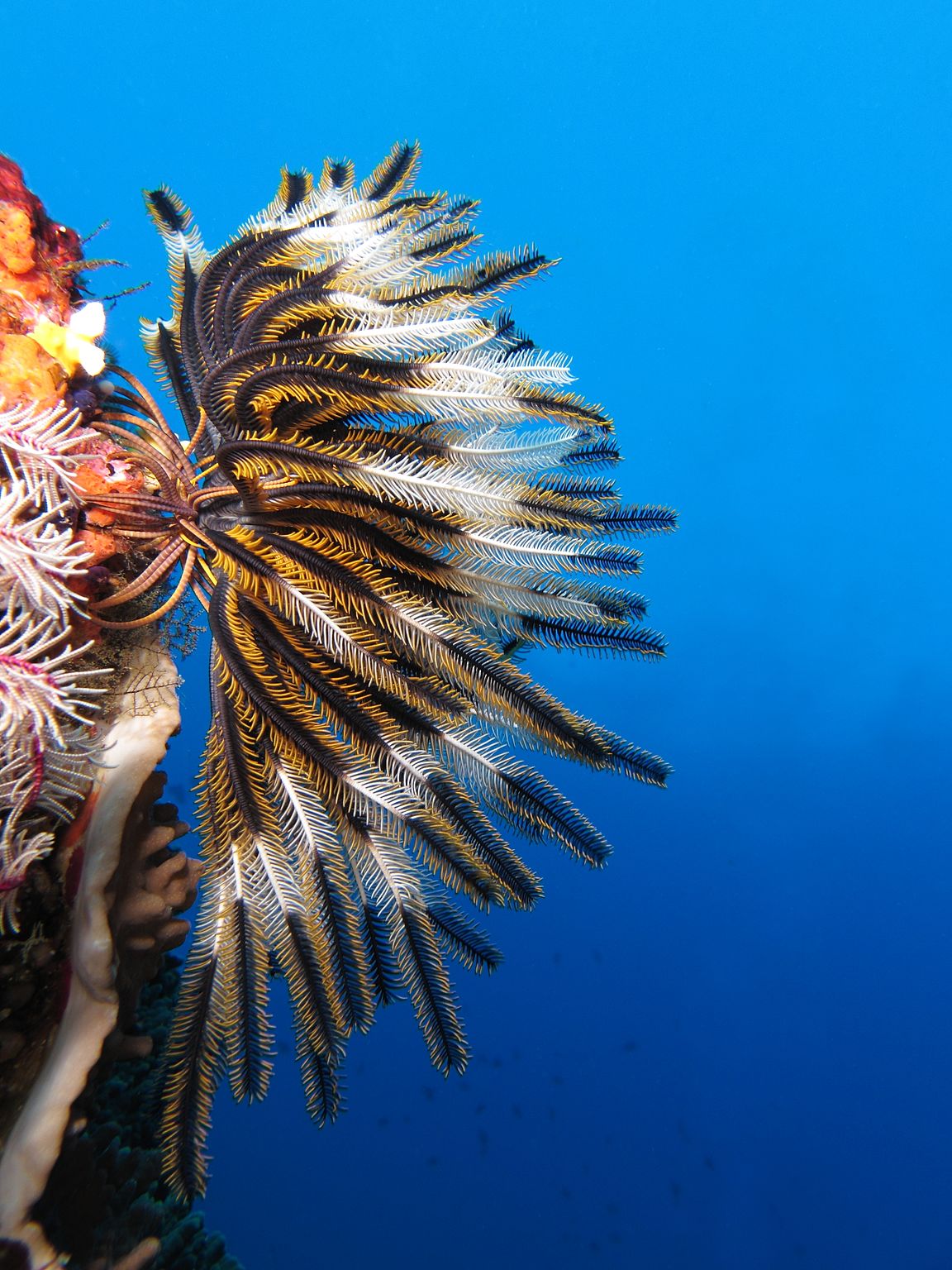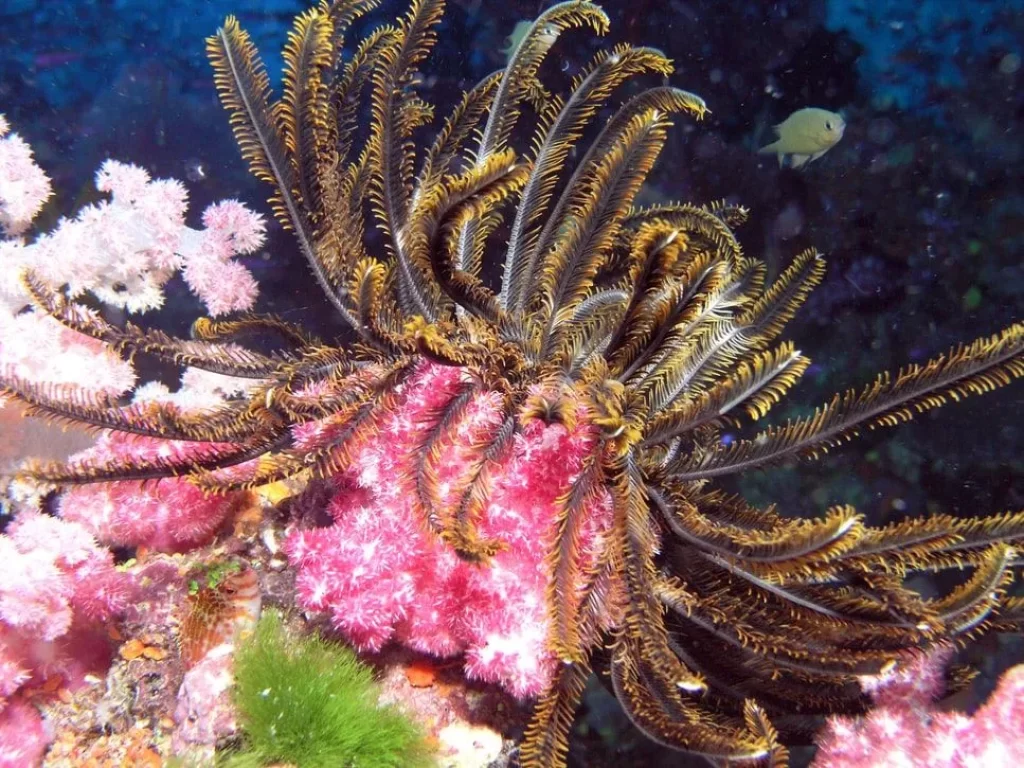
Feather stars are beautiful, but they’re also incredibly alien looking. These bristle-like appendages on the back of some Crinoids can be found all over the world in both freshwater and saltwater environments. Their feathery appearance is because these ‘arms’ are made from a papery layer that is shed regularly through moulting. The feathery appearance comes from this layer overlapping backwards slightly when it is discarded, providing a short tip to each arm. Feather stars generally grow in shallow water and their arms help them break through the surface tension of the water as they extend their feeding tentacles out to capture prey. In addition to breaking through the surface tension, these feathery appendages also helps with feeding because they allow Crinoids to obtain food from very small spaces where they would not be able to feed directly from the substrate otherwise.
What Is a Swimming Feather Star?
The most common feather star is the Feather Star (Astrocytium). This is a marine organism that can be found in many different environments. It is one of the few feather stars that can swim, and it can extend its feathery ‘arms’ to either side of its body while swimming. Feather stars are very common in the intertidal zone, where they grow on sand and rocks along the shore. You can find them in the subtidal zone, meaning they grow in water that is between the low tide mark and the high tide mark, such as in pools, lagoons, and other quiet waters. They can also grow in seawater. Feather stars can generally be found in areas with low to moderate salinity.
Why Are Swimming Feather Stars Called Swimming Creatures?
Feather stars are called swimming crinoids because they are able to move through the water just like a crinoid. A crinoid is any type of aquatic organism that has a stalk-like structure called a ‘corm’ or ‘core’ that supports the crinoid’s ‘trunks’, which are the feeding arms found on the feather star. Feather stars are technically crinoids that can swim because they have a core that supports their feeding arms. Feather stars swimming in the open ocean are called ‘bluetails’ or ‘swimming blue feathers’. Feather stars swimming in semi-enclosed waters are called ‘cormorants’. The feathery appearance of feather stars comes from their papery layer that is shed regularly through moulting. The feathery appearance comes from this layer overlapping backwards slightly when it is discarded, providing a short tip to each arm.

6 Types of the Swimming Feather Star
There are 6 different types of feather star found in the wild. The varieties include: – American feather star
1. pectinatus – Found from the Canadian to the Mexican coast, these feather stars can grow to 4 inches long. They can be found in shallow water near rocks, pilings, and other hard surfaces where they can break the surface tension of the water with their feathery arms. – Indo-Pacific feather star
2. edentiformis – This feather star is found in the Indo-Pacific region and can be found in both salt and fresh water. It has feathery arms that can be between 2 and 8 inches long. It can be found in waters with low to moderate salinity. – African feather star
3. eisenmanni – This is the only feather star that can be found in the Southern Hemisphere. It can be found in both fresh and salt water, and it can grow to be 4 inches long. It can be found near rocks, pilings, and other hard surfaces where it can break the surface tension of the water with its feathery arms. – Southern feather star
4. crassispinus – These feather stars are easily identifiable by their white coloration. They can grow to be 4 inches long and can be found in both salt and fresh water. They can be found near rocks, pilings, and other hard surfaces where they can break the surface tension of the water with their feathery arms. – Australian feather star
5. australis – These feather stars can be found in freshwater and brackish areas in Australia. They can grow to be 3 inches long and can be easily distinguished from other feather stars by their black coloration. – Chinese feather star
6. incurvus – These feather stars can be found in freshwater and brackish areas in China, Japan, Korea, and Vietnam. They can grow to be 3 inches long and are easily identifiable by their white coloration.
How to Take Care of a Swimming Feather Star?
Feather stars are generally low maintenance in terms of water conditions. They can be grown in both freshwater and seawater, with temperatures generally being a major factor in keeping them healthy. The ideal water temperature is between 72 and 84 degrees Fahrenheit. If you are growing these feather stars in seawater, try to keep them away from areas that experience waves because this can cause their feathery arms to be damaged. If they are kept in freshwater, they are completely saltwater tolerant and do not require any special care. The only thing you need to keep in mind is that feather stars will grow slower if they are in a hard water area. They should be fed a variety of plankton to keep them healthy. Feather stars can be fed once per week. To feed a feather star, use a plankton feeder and pour the plankton into the feeder. Then, place the feeder into the water and allow the plankton feeder to drift next to the feather star. The feather star will then be able to feed off of the plankton that drifts next to it.
Conclusion
Feather stars are beautiful, but they’re also incredibly alien looking. Feather stars are technically crinoids that can swim, and they can extend their feathery ‘arms’ to either side of their body while swimming. Feather stars are very common in the intertidal zone, where they grow on sand and rocks along the shore. You can find them in the subtidal zone, meaning they grow in water that is between the low tide mark and the high tide mark, such as in pools, lagoons, and other quiet waters. They can be found in areas with low to moderate salinity. Swimming feather stars are called swimming crinoids because they are able to move through the water just like a crinoid. Feather stars are low maintenance in terms of water conditions, growing in both fresh and saltwater, with temperatures generally being a major factor in keeping them healthy.






